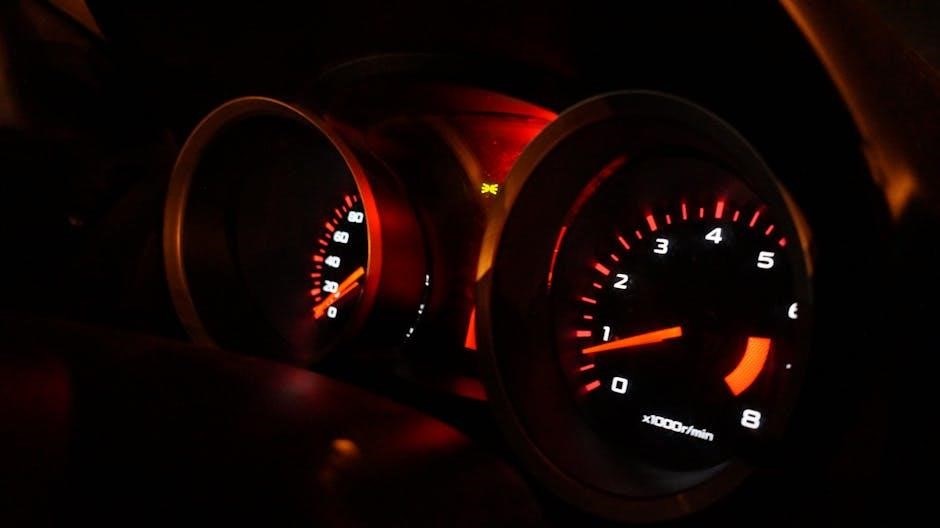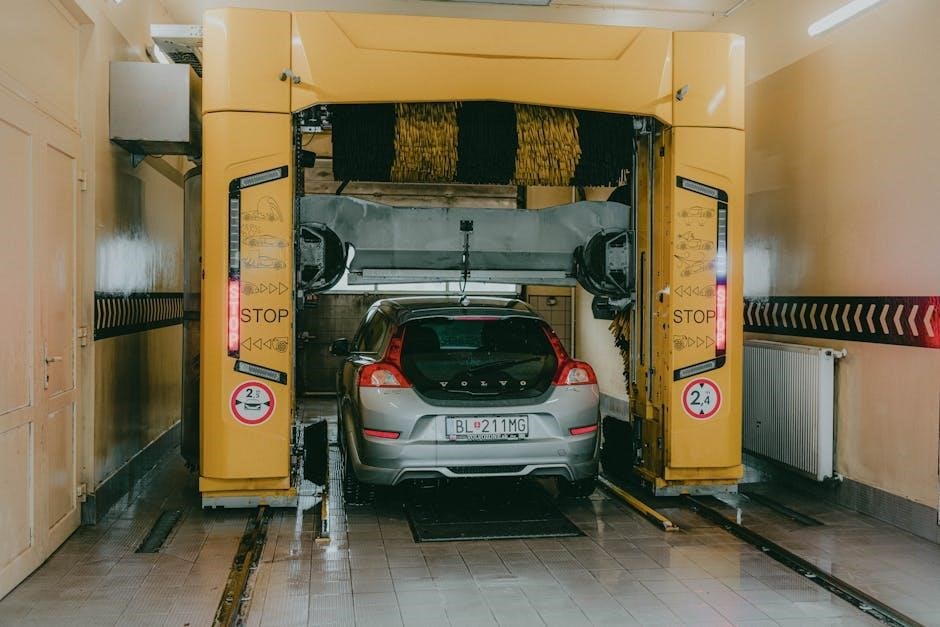both manual and automatic car
Manual and automatic cars are the two primary transmission types available. Manual transmissions‚ also known as stick-shift‚ require driver involvement with a clutch and gearshift. Automatic transmissions shift gears without manual intervention‚ offering convenience. Both options cater to different driving preferences and needs‚ balancing control and ease.
Overview of Transmission Types
Manual and automatic transmissions are the two primary types of car transmissions. Manual transmissions require the driver to manually shift gears using a clutch pedal and gearshift‚ providing more control over the vehicle. Automatic transmissions‚ in contrast‚ automatically change gears without driver intervention‚ offering convenience and ease of use. Both types have distinct mechanisms: manual transmissions rely on the driver’s input to engage the clutch and shift gears‚ while automatic transmissions use a torque converter and complex sensors to manage gear changes seamlessly. Additionally‚ some vehicles feature hybrid or dual transmissions‚ combining elements of both manual and automatic systems. These transmissions‚ such as automated manuals‚ allow for manual gear shifts without the need for a clutch pedal‚ blending the benefits of both worlds. Understanding these transmission types helps drivers choose the best option for their lifestyle and preferences.
Importance of Choosing the Right Transmission
Choosing the right transmission type is crucial for optimizing driving experience‚ fuel efficiency‚ and vehicle performance. Manual transmissions are often preferred by driving enthusiasts as they offer greater control‚ better fuel economy‚ and typically lower purchase costs. They are ideal for drivers who enjoy engaging with their vehicle and are comfortable with the learning curve of using a clutch and gearshift. On the other hand‚ automatic transmissions provide ease of use‚ especially in heavy traffic or hilly terrain‚ making them a practical choice for many commuters. They also eliminate the need to manually shift gears‚ reducing driver fatigue. Additionally‚ automatics are generally more convenient for new drivers or those who prioritize comfort over driving involvement. Selecting the appropriate transmission depends on factors such as driving habits‚ budget‚ and personal preference. Making the right choice ensures a smoother and more enjoyable ownership experience.

Manual Transmission Cars
Manual transmission cars offer a more engaging driving experience‚ requiring the use of a clutch and gearshift. They provide better fuel efficiency and cost less to purchase and maintain.
How Manual Transmissions Work
A manual transmission operates by connecting and disconnecting the engine from the wheels via a clutch pedal. When the driver presses the clutch‚ it disengages the engine‚ allowing gear shifts. The gearshift is then moved to select the desired gear‚ which determines the speed and torque ratio. Releasing the clutch slowly re-engages the engine with the transmission‚ providing power to the wheels. This process requires coordination between the clutch‚ accelerator‚ and gearshift to ensure smooth acceleration and avoid stalling. Manual transmissions typically have 4 to 6 forward gears and one reverse gear‚ each optimized for specific speed ranges. The driver must manually adjust gears based on driving conditions‚ such as speeding up or slowing down. This system relies on mechanical components‚ including the clutch‚ gearbox‚ and driveshaft‚ to transfer power efficiently. Proper synchronization of these elements ensures optimal performance and control.
Advantages of Manual Transmissions
Manual transmissions offer several advantages‚ including lower purchase costs and improved fuel efficiency. They provide better control over the vehicle‚ allowing drivers to optimize speed and torque for varying conditions. This increased engagement often results in a more enjoyable driving experience. Manual transmissions are also lighter and simpler in design‚ reducing the risk of mechanical failure and lowering maintenance costs. Additionally‚ they encourage safer driving habits‚ as constant gear shifting requires focus and attention. For eco-conscious drivers‚ manuals typically achieve better mileage in city driving compared to automatics. Overall‚ manual transmissions are a practical choice for those who value affordability‚ performance‚ and a hands-on driving connection. Their simplicity and efficiency make them a preferred option for many drivers worldwide.
Disadvantages of Manual Transmissions
Manual transmissions require constant driver engagement‚ as shifting gears and using the clutch can be tiring‚ especially in heavy traffic. This need for manual control may lead to driver fatigue on long journeys. Additionally‚ manual transmissions demand a learning curve‚ as mastering the clutch and gearshift can be challenging for new drivers. Stalling the car is a common issue for inexperienced drivers‚ which can be frustrating in stop-and-go situations. Manual cars also tend to roll backward on inclines if the brake is not applied properly‚ requiring extra caution. Furthermore‚ the physical effort of frequently using the clutch and gearshift can be inconvenient for drivers with mobility issues. While manuals offer benefits‚ these drawbacks make them less practical for some drivers‚ particularly in urban environments with frequent stops. These factors highlight why automatic transmissions are often preferred for ease and convenience.
Driving Experience with Manual Cars
Driving a manual car offers a unique and engaging experience‚ allowing drivers to feel more connected to the vehicle. The process of shifting gears and using the clutch provides a sense of control and precision‚ which many drivers find rewarding. However‚ it requires practice to master‚ as coordinating the clutch and accelerator smoothly can be challenging‚ especially for beginners. Stalling the car is a common issue for new drivers‚ but it becomes less frequent with experience. The physical engagement of shifting gears can be tiring in heavy traffic but is often outweighed by the satisfaction of driving. For enthusiasts‚ manual cars deliver a more immersive and thrilling driving experience. On the other hand‚ the constant need to shift gears can be less practical in urban settings with frequent stops. Overall‚ the driving experience with manual cars is a blend of skill‚ engagement‚ and enjoyment.

Automatic Transmission Cars
Automatic transmission cars simplify driving by eliminating manual shifting. They provide ease of use‚ especially in heavy traffic or hilly terrain‚ making them ideal for urban environments and less experienced drivers.
How Automatic Transmissions Work
Automatic transmissions operate by using a torque converter to connect and disconnect the engine from the transmission‚ allowing the car to move without manual shifting. A planetary gear set provides multiple gear ratios‚ enabling smooth acceleration. Sensors detect driving conditions‚ such as speed and throttle input‚ to determine the optimal gear. Hydraulic or electronic controls manage gear shifts seamlessly‚ ensuring efficient power delivery. This system eliminates the need for a clutch pedal‚ making driving more convenient. The transmission automatically adjusts to provide the right amount of power and speed for various driving situations‚ from city traffic to highway cruising. Modern automatics often include advanced features like adaptive shift logic‚ further enhancing performance and fuel efficiency. This hands-free shifting experience makes automatic cars a popular choice for many drivers.

Advantages of Automatic Transmissions
Automatic transmissions offer unparalleled convenience and ease of use‚ making them ideal for urban driving and heavy traffic. They eliminate the need for manual shifting‚ reducing driver fatigue and allowing focus on the road. With no clutch pedal‚ automatics are more accessible to new or inexperienced drivers. The smooth‚ seamless gear transitions provide a comfortable ride‚ especially in hilly or stop-and-go conditions. Modern automatics often feature advanced technologies like adaptive shift logic‚ enhancing fuel efficiency and performance. They are also well-suited for drivers who prioritize a relaxed driving experience. Additionally‚ automatics are less prone to stalling‚ making them a practical choice for challenging environments. Overall‚ the simplicity and convenience of automatic transmissions make them a preferred option for many drivers worldwide.
Disadvantages of Automatic Transmissions

Automatic transmissions have several drawbacks compared to manual counterparts. One major disadvantage is the higher cost of purchase and maintenance‚ as automatics are generally more complex and expensive to repair. They often consume more fuel‚ reducing fuel efficiency‚ especially in city driving conditions. Additionally‚ automatics provide less control over gear shifts‚ which can be a drawback for drivers who enjoy the engagement of manual driving. They also tend to have a slower acceleration response compared to manuals‚ as the transmission may hesitate during gear changes. In hilly or mountainous terrain‚ automatics can struggle with consistent braking and acceleration. Furthermore‚ the reliance on advanced technology means repairs can be more costly and time-consuming. For driving enthusiasts‚ the lack of direct control over gears can make the driving experience less rewarding. Overall‚ while automatics offer convenience‚ these limitations make them less appealing for certain drivers and conditions.
Driving Experience with Automatic Cars
The driving experience with automatic cars is characterized by ease and convenience. These vehicles eliminate the need for manual gear shifting‚ allowing drivers to focus solely on steering and braking. This makes automatics ideal for city driving‚ heavy traffic‚ and hilly terrains‚ where frequent gear changes would otherwise be required. The smooth acceleration and seamless transitions between gears provide a more relaxed driving experience. Additionally‚ automatics are generally easier to handle for new drivers‚ as they do not require coordination between the clutch and accelerator. However‚ some drivers find automatics less engaging compared to manuals‚ as they lack the tactile connection of shifting gears. Despite this‚ automatics are preferred for their simplicity and ease of use‚ making long drives more comfortable. They also reduce driver fatigue in stop-and-go traffic‚ as there is no need to constantly engage and disengage the clutch. Overall‚ automatic cars offer a hassle-free driving experience‚ catering to those who prioritize convenience over control.
